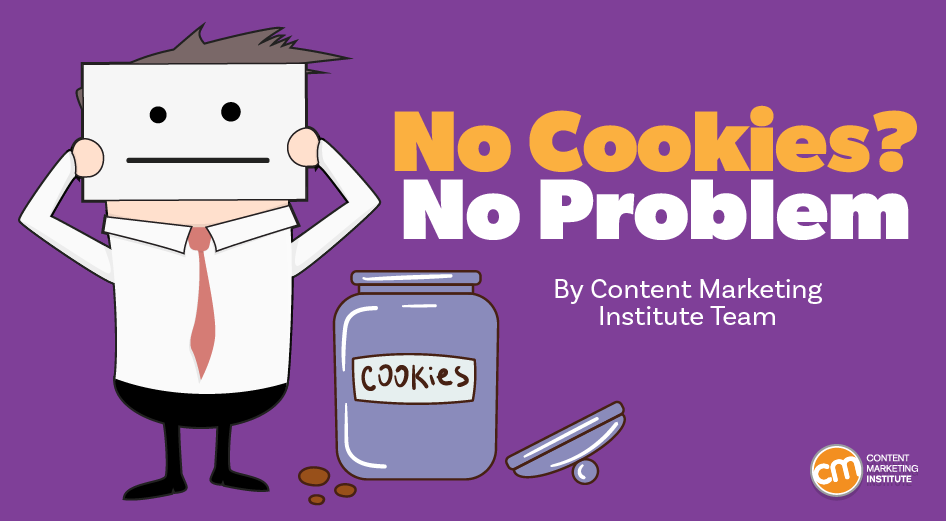Google followed through on its resolution to give up cookies.
Well, maybe “give up” is too strong to describe Google’s deprecation of its third-party cookies. It stopped tracking 1% of Chrome browser users to display content based on the attributes discovered in that tracking.
Estimates put global Chrome users at 3.2 billion people, so Google just killed off cookie access to about 32 million —that’s more than the population of Texas.
Are you ready for this Cookiepocalypse? Or in the UK, Biscuitpocalypse?
We’ve asked CMI’s chief strategy advisor, Robert Rose, to crack open this cookie and read the fortune for marketers. Watch or read on:
What is a cookie?
Before jumping into the impact of a cookie-less world, let me give you a quick 101 class on cookies. A cookie is a small file containing data about the user — or, more specifically, the device the person uses to browse the internet. This unique identification can inform other sites about where the user has been, the products they looked for, the searches they’ve conducted, etc.
Some internet users find cookies helpful. They allow them to stay logged into sites without re-entering their username and password, personalize the content, and remember the users’ preferences.
But most don’t realize there’s a difference between first-party and third-party cookies. The website viewed by the user gives them first-party cookies. Third-party cookies allow marketers, for example, to follow users with an ad for the same product a hundred times across different websites.
So, Google’s move really relates to the degradation of the third-party cookie as it relates to advertising. If you feel like you’ve already heard this news, you have. You’ve heard about it for at least a decade.
In 2013, Apple’s Safari and Mozilla’s Firefox restricted cookies from third-party advertisers. A few years later, Microsoft and other browser providers did the same. But they represent the minority of web users.
Google’s Chrome owns over 60% of the market share. So, its recent steps crumble the cookie world a lot more quickly.
What happens as the cookies crumble?
The world of advertising and marketing is about to change substantially, not just for the big media buys that cross thousands of publishing platforms. B2B will feel the impact, disrupting all the work over the years to match Google search advertising with B2B marketing and social platforms. It affects the optimization of search engine marketing and what individuals see when they visit your sites.
Preliminary data indicates that non-cookied Google Chrome users are monetized about 30% less than those with cookies. It’s just harder to target the buying audience without their cookies.
These early results match my hypothesis that much of the hype about cookies and data targeting was smoke and mirrors. My supposition was influenced by my reaction when I got targeted ads for stuff that I purchased or searched for and decided not to purchase.
However, the data prompts a more important takeaway. Marketers, especially in B2B industries, should see it as a tangible sign to get more active and deliberate about acquiring, using, and measuring first-party data.
See this as an increasingly important opportunity to know more about your customers so you can deliver better content, establish and build deeper relationships, and ultimately serve them more competitively than other platforms competing for their attention.
When I talk to my friends who aren’t in marketing, they have no idea they could opt out of cookies for years. And as Google and others limit the use of cookies, they still won’t care. They’ll just think the web got a little less creepy.
How do marketers dine on data?
Marketers must care about the deprecation of the third-party cookie. If you respond similarly to the industry’s ham-fisted, clumsy handling of customer privacy — posting big ol’ popups in users’ faces and making them click their heels four times to get back to Kansas — guess what? Your customers will blame you for the overbaked cookies.
How you handle the acquisition of customer data and the stewardship of that data is not a legal problem. It is not a technology problem. It won’t be solved by making it harder for your customers to get personal and relevant digital experiences.
The problem requires you to lean into your content strategy. What digital experiences can you build that will motivate audiences to give you their information so you can deliver more value to them over time?
HANDPICKED RELATED CONTENT:
Cover image by Joseph Kalinowski/Content Marketing Institute










